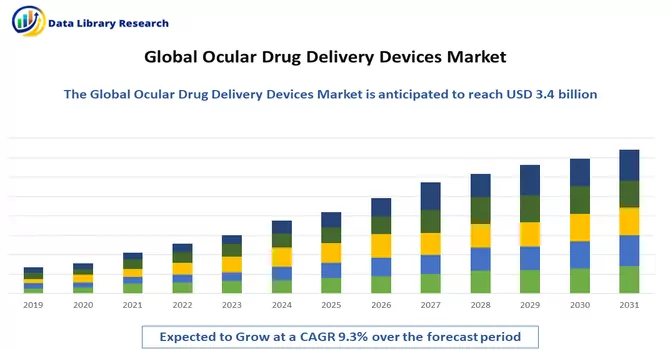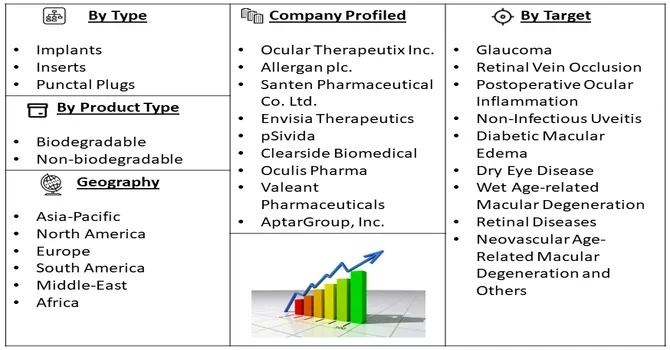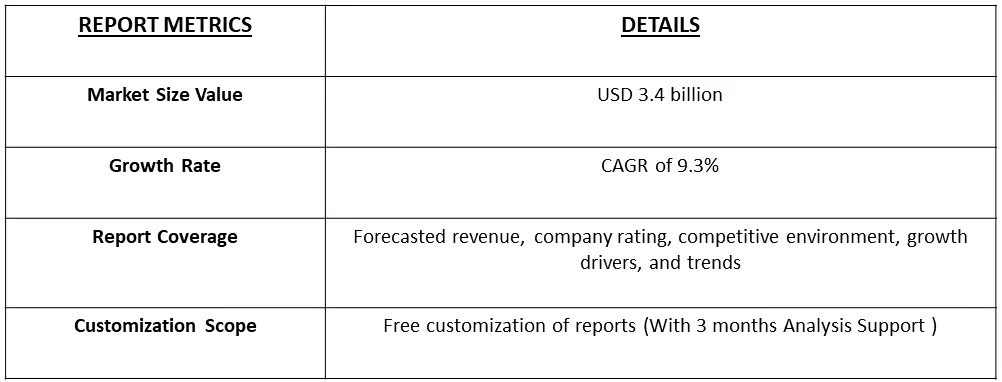In 2022, the global market for ophthalmic drug delivery systems achieved a value of USD13.4 billion and is anticipated to experience a steady expansion at a compound annual growth rate (CAGR) of 9.3% over the forecast period 2022 to 2030.

Get Complete Analysis Of The Report - Download Free Sample PDF
Ophthalmic drug delivery systems refer to specialized methods and technologies designed for the administration of pharmaceutical agents, such as drugs or medications, to the eyes. These systems are developed to efficiently deliver therapeutic substances to the targeted ocular tissues, including the cornea, conjunctiva, and retina, to treat various eye conditions and disorders. Ophthalmic drug delivery systems can take different forms, such as eye drops, ointments, gels, inserts, and sustained-release devices, each tailored to optimize drug absorption, bioavailability, and therapeutic efficacy within the eye structures. The primary goal is to enhance the delivery of drugs to the eye while minimizing side effects and improving patient compliance with the prescribed treatment regimen.
The predominant driver behind this growth is the escalating prevalence of eye disorders, including but not limited to cataracts, glaucoma, and age-related macular degeneration. Additionally, the market is being propelled by an increasing demand for targeted drug delivery technologies and recent advancements that improve bioavailability upon administration.
The global market for ophthalmic drug delivery systems is witnessing a surge in technological innovations. Advancements such as nanoparticle-based drug delivery, smart contact lenses, and sustained-release formulations are becoming increasingly prevalent, enhancing the precision and efficacy of drug administration. Another promising development is the integration of ophthalmic drug delivery systems with teleophthalmology services. This combination creates possibilities for remotely monitoring and managing eye conditions, especially in areas that lack access to specialized eye care. This integration not only improves patient outcomes but also aligns with the broader shift in healthcare towards digital and remote solutions.
Market Segmentation: The Ocular Drug Delivery System Market is Segmented by Type of Drug Delivery Device (Implants, Inserts and Punctal Plugs), Target Indications (Glaucoma, Retinal Vein Occlusion, Postoperative Ocular Inflammation, Non-Infectious Uveitis, Diabetic Macular Edema, Dry Eye Disease, Wet Age-related Macular Degeneration, Retinal Diseases, Neovascular Age-Related Macular Degeneration and Others), Type of Product (Biodegradable and Non-biodegradable) and Key Geographies (North America, Europe, Asia Pacific and Rest of the World). The value is provided in (USD million) for the above segments.

For Detailed Market Segmentation - Download Free Sample PDF
Market Drivers:
Rising Number of Eye Disorders Coupled With Growing Geriatric Population
The escalating prevalence of eye conditions, including cataracts, glaucoma, and age-related macular degeneration, is a significant driver of the growth in the market for ophthalmic drug delivery systems. According to the latest data from the World Health Organization (WHO), over 2.2 billion people worldwide are affected by near or distance vision impairment. The leading causes of distance vision impairment or blindness encompass cataract (94 million cases), refractive error (88.4 million cases), age-related macular degeneration (8 million cases), glaucoma (7.7 million cases), and diabetic retinopathy (3.9 million cases). Additionally, presbyopia is a major contributor to near vision impairment, affecting a substantial 826 million individuals. Conventional eye drops may not always offer sufficient and sustained drug concentrations in the affected areas, leading to challenges in effectively managing these widespread eye conditions. However, the advent of advanced drug delivery technologies, such as nanoparticles, microspheres, and sustained-release formulations, represents a significant breakthrough in addressing these limitations. These technologies empower healthcare professionals with better control over the release of medications, ensuring a more sustained and targeted delivery within the eye. By leveraging these advanced drug delivery mechanisms, the bioavailability of medications within the eye is markedly improved. This enhanced control over drug release enables a more efficient and prolonged therapeutic effect, overcoming the limitations associated with traditional eye drops. As a result, the adoption of these innovative drug delivery technologies is expected to contribute significantly to the growth of the ophthalmic drug delivery systems market throughout the forecast period.
Technological Advancement and Growing Product Approval
Moreover, the increasing need for advanced drug delivery technologies, along with recent innovations improving the effectiveness of administered drugs, is further propelling market growth. For instance, an article published by the Journal of Controlled Release in February 2023, reported that research are continuously looking for nanotechnology-based delivery systems that are currently investigated for treating and managing diseases affecting the anterior ocular tissues. Thus, such research are leading to development of better ocular drug delivery system, thereby propelling the studied market’s growth.
Similarly, in May 2023, Eyenovia announced FDA approval of Mydcombi, the First Ophthalmic Spray for Mydriasis leveraging the proprietary Optejet device platform. According to the company, this represents the first approved, fixed-dose combination of tropicamide and phenylephrine in the United States and the first product using Eyenovia’s proprietary Optejet device to be approved by any regulatory authority. Thus, such developments are expected to witness significant growth over the forecast period.
Market Restraints
Ocular Barriers and Complex Anatomy
The growth of the ocular drug delivery system is hindered by the presence of ocular barriers and the intricate anatomy of the eye. The eye's complex structure poses challenges for effective drug delivery, limiting the success of traditional methods. The tear film, composed of aqueous, mucin, and lipid layers, acts as a protective barrier. Frequent blinking further hinders drug retention and absorption. Efficient drug delivery systems must overcome these natural defence mechanisms to ensure sustained therapeutic levels. The eye is equipped with protective barriers such as the blood-aqueous barrier and blood-retinal barrier, which regulate the entry of substances into the intraocular spaces. These barriers limit the bioavailability of drugs, requiring specialized delivery systems to overcome the restrictions imposed by these physiological barriers. Thus, such factors are expected to slow down the growth of the studied over the forecast period.
The COVID-19 pandemic has had a multifaceted impact on the ophthalmic drug delivery system market, influencing various aspects ranging from production and supply chain disruptions to shifts in healthcare priorities. Research and development activities for new ophthalmic drug delivery technologies faced disruptions, with laboratories temporarily closing and researchers reassigning efforts to COVID-19-related research. Furthermore, increased interest in remote patient monitoring technologies emerged during the pandemic, potentially influencing the development of innovative drug delivery systems with integrated monitoring capabilities for ophthalmic conditions. Thus, the ophthalmic drug delivery system market is expected to rebound, driven by pent-up demand for eye care services and a gradual return to normalcy in healthcare operations. However, ongoing vigilance and adaptability to the evolving healthcare landscape will remain crucial for industry stakeholders navigating the post-pandemic environment.
Segmental Analysis :
Implants Segment is Expected to Witness Significant Growth Over the Forecast Period
Ocular drug delivery systems have witnessed significant advancements, and one notable innovation is the integration of implants to address challenges associated with conventional methods. Implants offer a promising avenue to enhance precision, bioavailability and sustained therapeutic effects in treating various eye conditions. Implants provide a targeted and localized approach to drug delivery within the eye. By directly implanting drug-eluting devices into specific ocular tissues, healthcare professionals can achieve more precise and effective drug concentrations at the site of action, minimizing systemic exposure and potential side effects. Implants are particularly advantageous for chronic eye conditions that require continuous therapy. Conditions like glaucoma or diabetic retinopathy benefit from sustained drug release provided by implants, ensuring consistent management of these ongoing diseases. Thus, such factors are expected to witness significant growth in the studied segment.
Glaucoma is Expected to Witness Significant Growth Over the Forecast Period
Glaucoma, a leading cause of irreversible blindness worldwide, poses significant challenges to effective treatment due to its chronic nature and the need for sustained intraocular pressure (IOP) management. Ocular drug delivery systems play a crucial role in addressing these challenges by providing innovative solutions for the targeted and sustained delivery of glaucoma medications. Glaucoma is characterized by elevated intraocular pressure, which, if left untreated, can lead to optic nerve damage and irreversible vision loss. Conventional treatments often involve the use of eye drops that require frequent administration, posing challenges related to patient compliance and efficacy over the long term. The ongoing research aims to refine the design and biocompatibility of ocular drug delivery systems for glaucoma.
Biodegradable is Expected to Witness Significant Growth Over the Forecast Period
The integration of biodegradable materials into ocular drug delivery systems represents a groundbreaking approach in the field of eye care. These innovative systems are designed to enhance the efficacy of treatments while minimizing environmental impact. Biodegradable systems offer the potential for incorporating multiple drugs or therapeutic agents into a single implant, facilitating combination therapies. This is particularly beneficial for addressing complex ocular conditions that may require a multifaceted treatment approach. Thus, the integration of biodegradable materials into ocular drug delivery systems represents a remarkable leap forward in the pursuit of sustainable and effective eye care. By combining targeted drug delivery with environmental considerations, these systems contribute to both therapeutic advancements and responsible healthcare practices. The ongoing evolution of biodegradable ocular drug delivery systems holds great potential for improving patient outcomes while minimizing the ecological footprint of medical interventions.
North America Region is Expected to Witness Significant Growth Over the Forecast Period
The North American region emerged as the dominant force in the ophthalmic drug delivery systems market, capturing the largest share of due to the notable achievement is ascribed to the presence of cutting-edge products and highly skilled professionals, a heightened emphasis on research and development by the government, and the well-established healthcare and research infrastructure. Additionally, the region's robust growth is fueled by an increasing incidence of eye disorders. The Centers for Disease Control and Prevention (CDC) reports that approximately 93 million adults in the U.S. are at a heightened risk of experiencing significant vision loss, further contributing to the burgeoning expansion of the market in North America.
The significant development for ophthalmic surgeries, the U.S. Food and Drug Administration (USFDA) granted 510(k) clearance to CorNeat Vision's groundbreaking innovation, the EverPatch, in June 2023. Positioned as the inaugural synthetic, non-degradable tissue-integrating matrix designed for ophthalmic procedures, the EverPatch comprises a non-woven polymer matrix that seamlessly integrates with surrounding tissue. Its primary purpose is to reinforce the sclera and contribute to the physical reconstruction of the ocular surface. Notably, the EverPatch is poised to revolutionize current practices by replacing the use of donor and processed tissue, a common approach in ocular surgeries that carries the inherent risk of disease transmission. The anticipated launch of EverPatch in leading ophthalmic centers across the United States in Q3 2023 marks a pivotal milestone, with plans for a nationwide expansion later in the year, underscoring its potential to redefine standards in ophthalmic surgical interventions. Thus, the region is expected to witness significant growth over the forecast period.

Get Complete Analysis Of The Report - Download Free Sample PDF
Major players in the manufacturing of ophthalmic drug delivery systems are strategically leveraging collaborations and partnerships to fortify their positions in the market. These initiatives serve as a pivotal strategy for expanding their customer base, fostering innovation, and creating greater awareness about eye disorders. The emphasis on strategic collaborations and partnerships among key players in the ophthalmic drug delivery systems market underscores a holistic approach aimed at innovation, market expansion, and awareness generation. By working in concert with various stakeholders, these companies are not only enhancing their competitive advantage but also contributing to the overall advancement of eye care solutions on a global scale.
Some of the prominent players in the ophthalmic drug delivery systems market include:
Recent Development:
1) In June 2023, Bausch + Lomb Corporation launched Bausch + Lomb INFUSE Multifocal silicone hydrogel (SiHy) daily disposable contact lenses in the United States. These lenses feature a cutting-edge material infused with ProBalance Technology, ensuring all-day comfort. Additionally, they incorporate the company's distinctive 3-Zone Progressive design, specifically addressing the evolving vision requirements of individuals with presbyopia. The lens provides clear vision with smooth transitions between near, intermediate, and distance vision, all while helping to minimize dryness associated with wearing contact lenses.
2) In June 2023, EyeCare Partners (ECP), introduced its latest initiative—the Advanced Comprehensive Ophthalmology Fellowship (ACOF). This one-year program is designed to elevate the skills and knowledge of aspiring ophthalmologists, simultaneously improving access to high-quality eye care for patients. ACOF will deliver extensive training to recent residency graduates, covering the latest advancements in ophthalmology, encompassing diagnostic and therapeutic techniques, surgical procedures, and clinical research. Thus, such initiaves are expected to bring treatment, and awareness that may contribute towards the market growth.
Q1. What was the Ocular Drug Delivery Devices Market size in 2022?
As Per Data Library Research the global market for Ocular Drug Delivery Devices Market achieved a value of USD13.4 billion in 2022.
Q2. At what CAGR is the Ocular Drug Delivery Devices Market projected to grow within the forecast period?
Ocular Drug Delivery Devices Market is anticipated to experience a steady expansion at a compound annual growth rate (CAGR) of 9.3% over the forecast period.
Q3. What are the factors driving the Ocular Drug Delivery Devices Market?
Key factors that are driving the growth include the Rising Number of Eye Disorders Coupled With Growing Geriatric Population and Technological Advancement and Growing Product Approval.
Q4. Who are the key players in Ocular Drug Delivery Devices Market?
Some key players operating in the market include
Data Library Research are conducted by industry experts who offer insight on industry structure, market segmentations technology assessment and competitive landscape (CL), and penetration, as well as on emerging trends. Their analysis is based on primary interviews (~ 80%) and secondary research (~ 20%) as well as years of professional expertise in their respective industries. Adding to this, by analysing historical trends and current market positions, our analysts predict where the market will be headed for the next five years. Furthermore, the varying trends of segment & categories geographically presented are also studied and the estimated based on the primary & secondary research.
In this particular report from the supply side Data Library Research has conducted primary surveys (interviews) with the key level executives (VP, CEO’s, Marketing Director, Business Development Manager and SOFT) of the companies that active & prominent as well as the midsized organization
FIGURE 1: DLR RESEARH PROCESS

Extensive primary research was conducted to gain a deeper insight of the market and industry performance. The analysis is based on both primary and secondary research as well as years of professional expertise in the respective industries.
In addition to analysing current and historical trends, our analysts predict where the market is headed over the next five years.
It varies by segment for these categories geographically presented in the list of market tables. Speaking about this particular report we have conducted primary surveys (interviews) with the key level executives (VP, CEO’s, Marketing Director, Business Development Manager and many more) of the major players active in the market.
Secondary ResearchSecondary research was mainly used to collect and identify information useful for the extensive, technical, market-oriented, and Friend’s study of the Global Extra Neutral Alcohol. It was also used to obtain key information about major players, market classification and segmentation according to the industry trends, geographical markets, and developments related to the market and technology perspectives. For this study, analysts have gathered information from various credible sources, such as annual reports, sec filings, journals, white papers, SOFT presentations, and company web sites.
Market Size EstimationBoth, top-down and bottom-up approaches were used to estimate and validate the size of the Global market and to estimate the size of various other dependent submarkets in the overall Extra Neutral Alcohol. The key players in the market were identified through secondary research and their market contributions in the respective geographies were determined through primary and secondary research.
Forecast Model
